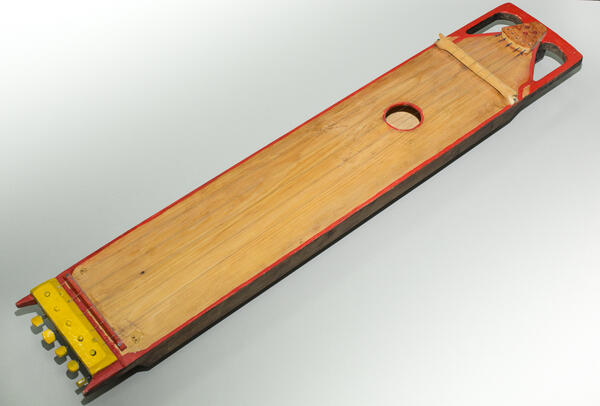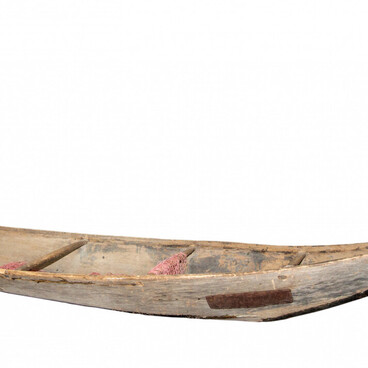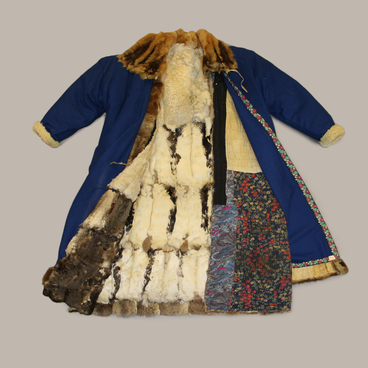The nares-jux is a traditional Khanty plucked string instrument. Its name is translated into Russian as “singing tree”. The nares-jux is also the name for a boat because of the similarity of shapes.
The musical instrument was usually made from spruce or aspen. The top cover was glued to the body with the glue made from fish entrails.
One end of the nares-jux was pointed while the other was forked into two arms which carry a crossbar with the attached strings. Their number varied from three up to five. Initially, strings were made from reindeer tendons or entrails. A cross-typed sound hole was cut on the surface of the instrument. There were also crossbars that supported the strings. After being attached to crossbars, the strings were tied into a knot and fastened to the pointed end.
In the old days, the nares-jux was considered to be an exclusively male musical instrument. When playing, it was placed on the knees of the musician, in a horizontal position, slightly tilted. The principle of playing the nares-jux is similar to playing the Russian instrument — gusli. The musician plucked the strings with one hand, and toned sounds with the other. To do this, he pressed his fingers to certain parts of the instrument. At the same time, the length of the string decreased, due to which the sound changed.
With the accompaniment of the nares-jux, the Khanty sang songs about events in the life of the spirits, about the feats of the legendary heroes. This musical instrument was played during the bear feast, one of the main celebrations among the Khanty. The nares-jux was also used as a shamanic attribute during kamlania rituals (this is the name of the ritual during which the shaman communicates with the spirits). No shaman ever sold his nares-jux. The Khanty believed that if a person sold an instrument, he sold his soul.
In the exhibition “Ugra Heritage”, on the display “Bear Feast”, there is a nares-jux, which was made in 1993. The same year, it was given to the Museum of the Ob River. Modern nares-jux differs from those musical instruments of the past. A round sound hole is cut on the surface, not a cross-type one, there are no forked crossbars on the body, and instead of strings made of tendons, there are ordinary metal strings. Such instruments are used not only by the indigenous inhabitants of the Nefteyugansk District, but also by ensembles of the folk music.
The musical instrument was usually made from spruce or aspen. The top cover was glued to the body with the glue made from fish entrails.
One end of the nares-jux was pointed while the other was forked into two arms which carry a crossbar with the attached strings. Their number varied from three up to five. Initially, strings were made from reindeer tendons or entrails. A cross-typed sound hole was cut on the surface of the instrument. There were also crossbars that supported the strings. After being attached to crossbars, the strings were tied into a knot and fastened to the pointed end.
In the old days, the nares-jux was considered to be an exclusively male musical instrument. When playing, it was placed on the knees of the musician, in a horizontal position, slightly tilted. The principle of playing the nares-jux is similar to playing the Russian instrument — gusli. The musician plucked the strings with one hand, and toned sounds with the other. To do this, he pressed his fingers to certain parts of the instrument. At the same time, the length of the string decreased, due to which the sound changed.
With the accompaniment of the nares-jux, the Khanty sang songs about events in the life of the spirits, about the feats of the legendary heroes. This musical instrument was played during the bear feast, one of the main celebrations among the Khanty. The nares-jux was also used as a shamanic attribute during kamlania rituals (this is the name of the ritual during which the shaman communicates with the spirits). No shaman ever sold his nares-jux. The Khanty believed that if a person sold an instrument, he sold his soul.
In the exhibition “Ugra Heritage”, on the display “Bear Feast”, there is a nares-jux, which was made in 1993. The same year, it was given to the Museum of the Ob River. Modern nares-jux differs from those musical instruments of the past. A round sound hole is cut on the surface, not a cross-type one, there are no forked crossbars on the body, and instead of strings made of tendons, there are ordinary metal strings. Such instruments are used not only by the indigenous inhabitants of the Nefteyugansk District, but also by ensembles of the folk music.



